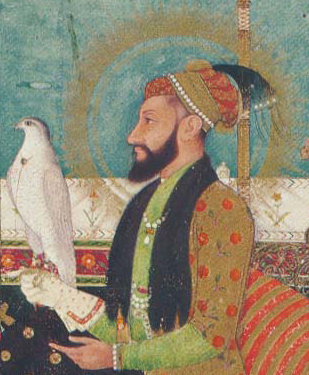
Muhi al-Din Muhammad, commonly known as Aurangzeb, was the sixth Mughal emperor, reigning from 1658 until his death in 1707. His regnal name is Alamgir I, which derived from his title, Abu al-Muzaffar Muhi-ad-Din Muhammad Bahadur Alamgir Aurangzeb Badshah al-Ghazi. Under his emperorship, the Mughal Empire reached its greatest extent with territory spanning nearly the entirety of the Indian subcontinent.

Mirza Abu'l Fayaz Qutb-ud-Din Mohammad Azam, commonly known as Azam Shah, was briefly the seventh Mughal emperor from 14 March to 20 June 1707. He was the third son of the sixth Mughal emperor Aurangzeb and his chief consort Dilras Banu Begum.
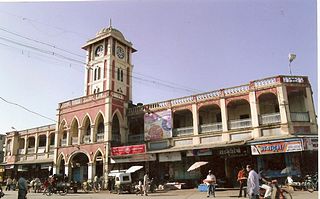
Miraj is a city that is part of the Sangli-Miraj-Kumand metropolitan region in Sangli district, Maharashtra. Founded in the early 10th century, Miraj was an important jagir of the Bijapur Sultanate.
The Deccan Sultanates were five late-medieval Indian kingdoms—on the Deccan Plateau between the Krishna River and the Vindhya Range—that were ruled by Muslim dynasties: namely Ahmadnagar, Berar, Bidar, Bijapur, and Golconda. The sultanates had become independent during the break-up of the Bahmani Sultanate. The five sultanates owed their existence to the declaration of independence of Ahmadnagar in 1490, followed by Bijapur and Berar in the same year. Golconda became independent in 1518, and Bidar in 1528.

Ali Adil Shah II was the 8th Sultan of Bijapur. He succeeded to the throne of Bijapur through the efforts of the Prime Minister Khan Muhammad and the Queen, Badi Sahiba, sister of Qutb Shah of Golkonda on the death of Mohammed Adil Shah, Sultan of Bijapur on 4 November 1656.

Sikandar Adil Shah was the last Sultan of Bijapur, who reigned between 1672 and 1686. Placed on the throne at five years of age, his reign was marked by the collapse of the Bijapur Sultanate.
Qasim Yakut Khan also known as Yakut Shaikhji, Yakub Khan and Sidi Yaqub was a naval Admiral and administrator of Janjira Fort who first served under Bijapur Sultanate and later under the Mughal Empire.

Panhala fort, is located in Panhala, 20 kilometres northwest of Kolhapur in Maharashtra, India. It is strategically located looking over a pass in the Sahyadri mountain range which was a major trade route from Bijapur in the interior of Maharashtra to the coastal areas. Due to its strategic location, it was the centre of several skirmishes in the Deccan involving the Marathas, the Mughals and the British the grand son's of chhatrapati shivaji maharaj East India Company, the most notable being the Battle of Pavan Khind. Here, the queen regent of Kolhapur, Tarabai Ranisaheb, spent her formative years. Several parts of the fort and the structures within are still intact. It is also called as the 'Fort of Snakes' as it is zigzagged in shape.
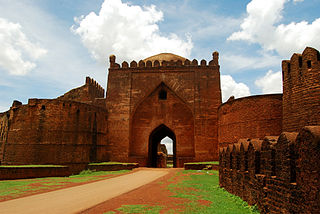
Bidar Fort is located in old city area, Bidar, Karnataka, India. The fort, the city and the district are all affixed with the name Bidar. Sultan Ahmad Shah I of the Bahmanid dynasty shifted his capital from Gulbarga to Bidar in 1427 and built his fort along with a number of Islamic monuments. There are over 30 monuments inside Bidar fort.

The Bijapur Fort is located in the Bijapur city in Bijapur District of the Indian state of Karnataka. Bijapur fort has a plethora of historical monuments of architectural importance built during the rule of Adil Shahi dynasty.

The siege of Bijapur began in March 1685 and ended in September 1686 with a Mughal victory. The siege began when Aurangzeb dispatched his son, Muhammad Azam Shah, with a force of nearly 50,000 men to capture Bijapur Fort and defeat Sikandar Adil Shah, the then ruler of Bijapur, who refused to be a vassal of the Mughal Empire. The siege of Bijapur was among the longest military engagements of the Mughals, lasting more than 15 months until Aurangzeb personally arrived to organize a victory.

The siege of Jinji,, began when the Mughal Emperor Aurangzeb appointed Zulfiqar Ali Khan as the Nawab of the Carnatic and dispatched him to besiege and capture Jinji Fort, which had been sacked and captured by Maratha Empire troops led by Rajaram, they had also ambushed and killed about 300 Mughal Sowars in the Carnatic. The Mughal Emperor Aurangzeb then ordered Ghazi ud-Din Khan Feroze Jung I to protect the supply routes leading to Jinji Fort and to support and provide reinforcements to Zulfiqar Ali Khan when needed.

The Battle of Purandar was fought between the Mughal Empire and the Maratha Empire in 1665.
The Mughal war of succession (1707–1709) or the Mughal Civil War was a period of political disorder and armed conflict over succession in the Mughal Empire following the death of the sixth Mughal emperor Aurangzeb in March 1707.
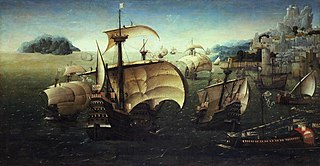
The War of the League of the Indies was a military conflict in which a pan-Asian alliance formed primarily by the Sultanate of Bijapur, the Sultanate of Ahmadnagar, the Kingdom of Calicut, and the Sultanate of Aceh, referred to by the Portuguese historian António Pinto Pereira as the "league of kings of India", "the confederated kings", or simply "the league", attempted to decisively overturn Portuguese presence in the Indian Ocean through a combined assault on some of the main possessions of the Portuguese State of India: Malacca, Chaul, Chale fort, and the capital of the maritime empire in Asia, Goa.
the Raid of Ahmednagar took place in 1657, when the Marathas led by Shivaji penetrated as far as Ahmednagar in hopes of asseting Bijapur Sultan, the raid, however, was repulsed.

The Deccan Sultanates-Vijayanagara Conflicts were a prolonged period of military conflict lasting from 1495 to 1614 This series of battles pitted the rival powers of the Deccan Sultanates against the Vijayanagara Empire. Over the course of approximately 120 years, these two entities engaged in a series of wars and skirmishes that were marked by significant displays of military strength and strategic maneuvering.

The Siege of Panhala was led by Siddi Jauhar on behalf of the Bijapur Sultanate, dispatched by Ali Adil Shah II to reclaim the Panhala Fort, was a momentous undertaking. Shivaji had seized Panhala on 28 November 1659, just 18 days after the death of Afzal Khan at Pratapgad. Despite the efforts of two of Bijapur Sultanate’s prominent commanders, Afzal Khan and Rustam Zaman, who had both failed in their attempts to capture Shivaji, victory eluded them. With Bijapur running short of options and facing the expanding influence of Shivaji, the responsibility of bringing this campaign to a conclusion fell on Siddi Jauhar. By taking on this pivotal role, Siddi Jauhar finally earned favor at the Bijapur court, leading to the restoration of the Kurnool district to him, and Shivaji had to surrender the Panhala fort.
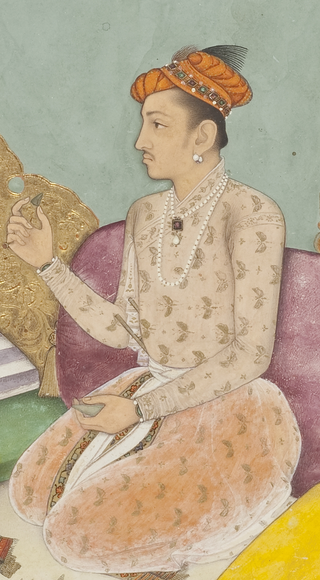
Mughal Commander Jai Singh Invaded Bijapur on orders of Aurangzeb where he met failure as he was repulsed by Rataji Mane a Maratha commander under Bijapur.

The Shivaji's invasions of Janjira were a series of military campaigns launched by the first Maratha ruler, Shivaji, against the Abyssinian rulers of the sea fortress of Janjira named Siddis between 1661 and 1676. The Marathas attacked the Janjira fort annually, and during the final siege of 1676, the Maratha Peshwa Moropant faced a counterattack by the Siddis, forcing the Marathas to retreat with heavy casualties.















